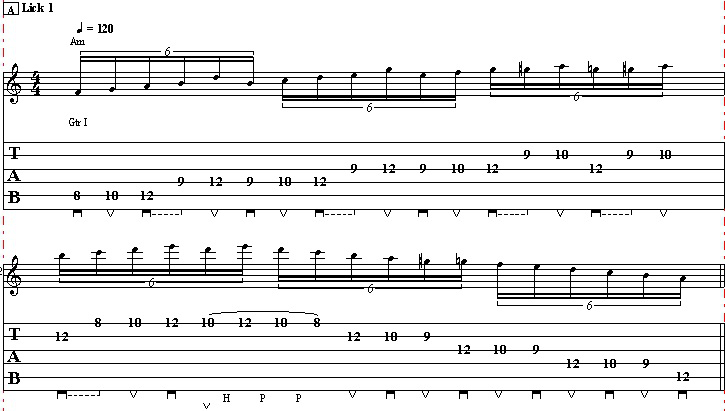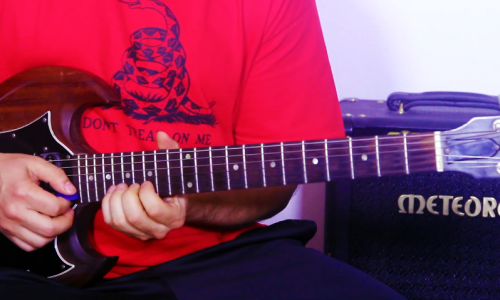Hey, how’s it going this is Sean Daniel with Guitar Control, today we’re going to learn how to play a Classic much underrated song called “Everywhere” by Fleetwood Mac. We’re going to do a way where we can do it all acoustically, to get their rhythm and the spirit of the song by combining a couple different parts.
A very easy way to arrange it is to play and sing it at the same time, so make sure you click on the Tab button to follow the chords and tabs.
I’m going to cord out all the chords, it’s going to be in the Key of E, and the others will sound like this. It’s like a fun rhythmic thing that you can do, we’re going to focus mainly on power chords for all these and we only use four chords which are really cool; let’s do 7a with pointer finger 9D, and 9G. Now, this is going to be the representative of E major chord, do the exact same thing with but I want to do this in this spot of the neck, because I’m going to move it all around and stay in one shape of the neck. So what we’re going to do is a strumming pattern, so root down, up, down, into the next chord.
This is if you listen to what Lindsey Buckingham, master guitar player is doing it’s like we’re going to do a fuller version, so it’s more of an acoustic thing, so if we have this one, two, and three, your ring finger is going to grab the ninth fret on the a string which will lead you into this B major chord.
Now, again doesn’t have to be a full B major barre chord and it can give you a really nice sound, but we’re going to focus on 7e, 9a, 9d and then 8g, don’t worry about the top few strings because those are hard ones to bomber, we don’t need to use a bar chord to do this we can do the exact same thing with just power chords if you want, so 7a this is going to be the E chord even if it’s seven, nine, and nine, one, two, and three, ring finger moves up a string and then pointer finger falls in line and then we’re going to grab the next chord which is B major board or just play the power chord one, two, three, four, five, six, seven, so if we have an eight count that’s how I like to organize the song. Just get that down because that’s the main hall of this song.
After this we’re going to descend through chords in the Key of E, starting on the 6th chord. Knowing the core degrees and where they fall in a key is a super valuable thing. It’s a grand way to remember how things sound because backing through the scale through those notes chords in the Key of E which is 9, 7, 5, or C sharp B, A, technically B, C sharp minor, to B major, to A major, but we can use these power cords to make it easier for ourselves so we’ve got to make it more lively, but basically this is the structure of the song however you want to play it depending on how lively you want to make it, or how chill you want to make it is totally up to you.
This is going to be the verse of the song and then we have the chorus which is going to sound like this, so we’re kind of dancing around the C sharp, the B, and the A chord back and forth. The structure of it would start with the B.
Now, I want to talk about the count because a an over counting in fours, there’s over no over going to bar before we can get to the next chord on the 4, where if we have a count of four we’re going to the next chord in the progression on the four count one, two, three, four, one, two, three, four, now we have that first bar which is split between three beats of B one, two, and three, four, one, two, now I have a full bar after we’re stealing one of the counts in the previous bar for C sharp one, two, three, four a.
Think always of sneaking into that previous bar with the next chord for any of these progressions then. What I like to do is to combined chord progressions together to make them two chords at a time we’ve got B to C sharp one, two, three, four, that’s the first couple then we have A to B.
And you’re going to end on the open D chord, the ultimate resolution in the Key of E. A real quick while we talk about the numbers of this chord progression because it can really help to translate and transpose them into different keys. I promise even if you’ve never thought about like music theory and stuff there’s stuff you want to know, so if E is the 1 chord we can just go through all the alphabetical numbers that make that chord.
Always do that with a major scale, here’s one, F sharp is two, G sharp as 3, A is 4, B is 5, C sharp is 6, and then D sharp is 7, if we turn all these chords into numbers it becomes much easier to remember so instead of E to B, we can go one, two, five, one, two, five, and then for the course it becomes so much easy to remember because it’s just five to six, four to five, sixth and five, four, five, then one.
I want to make this a whole music theory lesson, but it’s something that I’m tricking you all into learning over time through this incredible bubblegum pop song which is really a lot of fun to play. Last Pro tip for the day, the very last thing we do before the ending E minor, C sharp, B, A, B to E, this B major to E can be tricky when you’re moving hand positions through the neck, just keep your hand shape like this slide it all the way down pop that pointer finger off Big E major, hopefully you’re going to play great pop song, Mac Fleetwood would be so proud of you, he already is.
Make sure to subscribe on our You Tube Channel and we’ll see you in our next video lessons, thanks for watching




